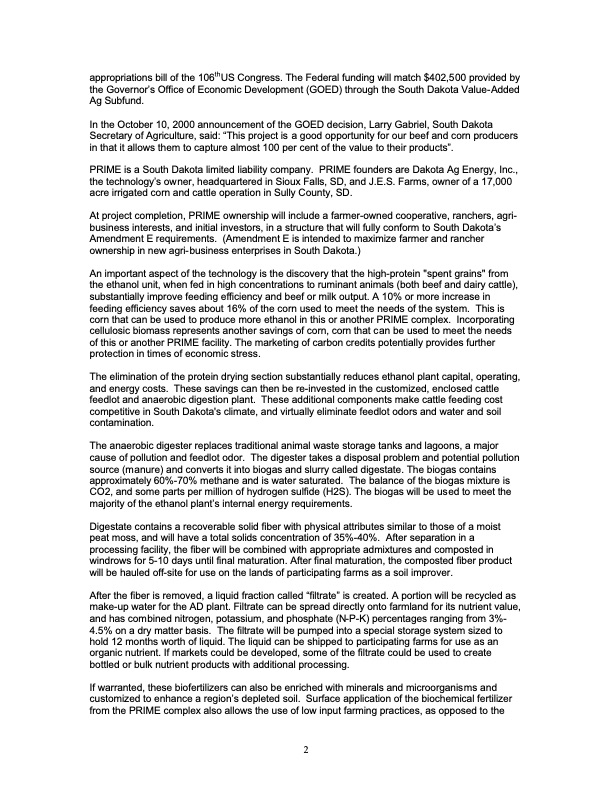
PDF Publication Title:
Text from PDF Page: 002
appropriations bill of the 106thUS Congress. The Federal funding will match $402,500 provided by the Governor’s Office of Economic Development (GOED) through the South Dakota Value-Added Ag Subfund. In the October 10, 2000 announcement of the GOED decision, Larry Gabriel, South Dakota Secretary of Agriculture, said: “This project is a good opportunity for our beef and corn producers in that it allows them to capture almost 100 per cent of the value to their products”. PRIME is a South Dakota limited liability company. PRIME founders are Dakota Ag Energy, Inc., the technology’s owner, headquartered in Sioux Falls, SD, and J.E.S. Farms, owner of a 17,000 acre irrigated corn and cattle operation in Sully County, SD. At project completion, PRIME ownership will include a farmer-owned cooperative, ranchers, agri- business interests, and initial investors, in a structure that will fully conform to South Dakota’s Amendment E requirements. (Amendment E is intended to maximize farmer and rancher ownership in new agri-business enterprises in South Dakota.) An important aspect of the technology is the discovery that the high-protein "spent grains" from the ethanol unit, when fed in high concentrations to ruminant animals (both beef and dairy cattle), substantially improve feeding efficiency and beef or milk output. A 10% or more increase in feeding efficiency saves about 16% of the corn used to meet the needs of the system. This is corn that can be used to produce more ethanol in this or another PRIME complex. Incorporating cellulosic biomass represents another savings of corn, corn that can be used to meet the needs of this or another PRIME facility. The marketing of carbon credits potentially provides further protection in times of economic stress. The elimination of the protein drying section substantially reduces ethanol plant capital, operating, and energy costs. These savings can then be re-invested in the customized, enclosed cattle feedlot and anaerobic digestion plant. These additional components make cattle feeding cost competitive in South Dakota's climate, and virtually eliminate feedlot odors and water and soil contamination. The anaerobic digester replaces traditional animal waste storage tanks and lagoons, a major cause of pollution and feedlot odor. The digester takes a disposal problem and potential pollution source (manure) and converts it into biogas and slurry called digestate. The biogas contains approximately 60%-70% methane and is water saturated. The balance of the biogas mixture is CO2, and some parts per million of hydrogen sulfide (H2S). The biogas will be used to meet the majority of the ethanol plant’s internal energy requirements. Digestate contains a recoverable solid fiber with physical attributes similar to those of a moist peat moss, and will have a total solids concentration of 35%-40%. After separation in a processing facility, the fiber will be combined with appropriate admixtures and composted in windrows for 5-10 days until final maturation. After final maturation, the composted fiber product will be hauled off-site for use on the lands of participating farms as a soil improver. After the fiber is removed, a liquid fraction called “filtrate” is created. A portion will be recycled as make-up water for the AD plant. Filtrate can be spread directly onto farmland for its nutrient value, and has combined nitrogen, potassium, and phosphate (N-P-K) percentages ranging from 3%- 4.5% on a dry matter basis. The filtrate will be pumped into a special storage system sized to hold 12 months worth of liquid. The liquid can be shipped to participating farms for use as an organic nutrient. If markets could be developed, some of the filtrate could be used to create bottled or bulk nutrient products with additional processing. If warranted, these biofertilizers can also be enriched with minerals and microorganisms and customized to enhance a region’s depleted soil. Surface application of the biochemical fertilizer from the PRIME complex also allows the use of low input farming practices, as opposed to the 2PDF Image | New Integrated Ethanol-Feedlot-Methane System Under Development in South Dakota

PDF Search Title:
New Integrated Ethanol-Feedlot-Methane System Under Development in South DakotaOriginal File Name Searched:
biogas15.pdfDIY PDF Search: Google It | Yahoo | Bing
Capstone Turbine and Microturbine: Capstone microturbines used and new surplus for sale listing More Info
Consulting and Strategy Services: Need help with Capstone Turbine, sizing systems, applications, or renewable energy strategy, we are here to assist More Info
Container Lumber Dry Kiln: Since 1991 developing and innovating dry kilns using standard shipping containers More Info
Supercritical CO2 Lumber Dry Kiln: Compact fast drying in 3 days or less for small amounts of wood and lumber drying More Info
BitCoin Mining: Bitcoin Mining and Cryptocurrency... More Info
Publications: Capstone Turbine publications for microturbine and distributed energy More Info
FileMaker Software for Renewable Energy Developing database software for the renewable energy industry More Info
CO2 Gas to Liquids On-Demand Production Cart Developing a supercritical CO2 to alcohol on-demand production system (via Nafion reverse fuel cell) More Info
Stranded Gas for low cost power Bitcoin Mining Using stranded gas for generators may provide breakthrough low power costs for cryptocurrency miners. More Info
| CONTACT TEL: 608-238-6001 Email: greg@globalmicroturbine.com | RSS | AMP |